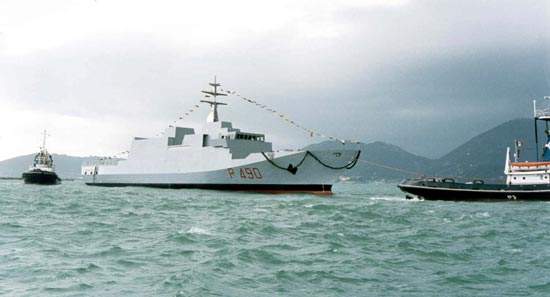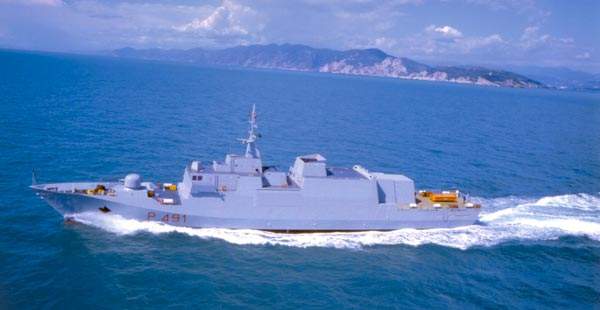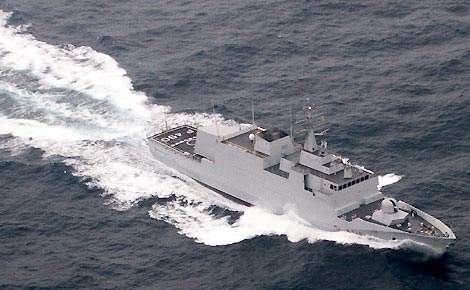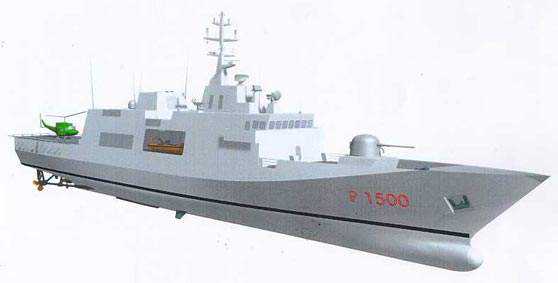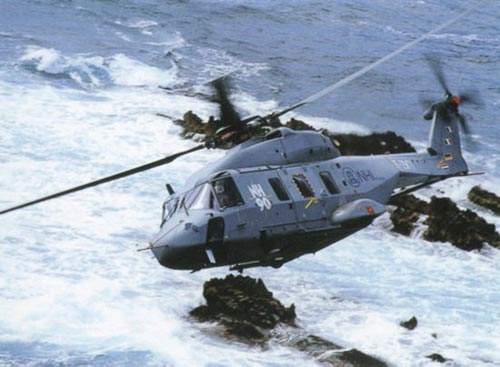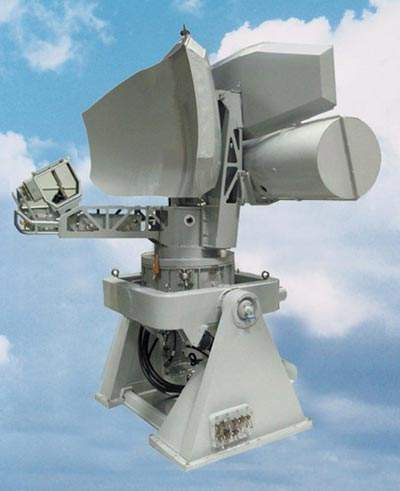Four Commandante Class (Classe Comandanti) light combatant ships were built for the Italian Navy by Fincantieri at the Riva Trigoso shipyard. The programme is also known as NUMC (Nuove Unità Minori Combattenti or New Minor Combatant). The first of class, Commandante Cigala Fulgosi (P490), and the Commandante Borsini (P491) were commissioned in 2002, Commandante Bettica (P492) in 2003 and Commandante Foscari (P493) in 2004.
Two additional ships, the Sirio (P409) and the Orione (P410), were built for the Italian Ministry of Transport but are crewed by the navy. They were commissioned in 2005 and are known as NUPA (Nuove Unità di Pattugliamento d’Altura) and have less powerful engines and weapons and no helicopter hangar or countermeasures.
Fincantieri is the prime contractor for the platform, Selex Sistemi Integrati (formerly Alenia Marconi Systems) for the ship’s combat system and Elmer has been awarded the contract for the communications system.
Commandante Class mission roles
The ship’s main missions are long and medium-range patrol and the vessel carries fuel and stores for an endurance of ten days. The main patrol missions are primarily for surveillance and secondly for surface combat operations.
The missions include establishing presence in and patrolling international waters, patrolling and guarding maritime borders and surveillance of the exclusive economic zone.
The ship operates with a crew of 80 with eight officers. The overall length is 88.40m and the full load displacement is 1,520t. The maximum sustained speed is over 25kt and the ship has a range of 3,500nm.
The ship design incorporates low radar and infrared signatures. The first three vessels have an all-steel superstructure, but the fourth, Commandante Foscari, is constructed from glass-reinforced plastic, including most of the mast and the helicopter hangar. This composite material is lighter and therefore reduces fuel consumption.
Cigala Fulgosi corvette
The ship bears the name of an officer of the Italian Navy, Captain Joseph Fulgosi Cigala. The offshore patrol vessel (OPV) was decorated with the Medaglia d’oro al Valor Militare and is the first in the class of four units.
The ship has a stern, a mirror, a flight deck with access to hangar. It can easily accommodate AB212 and NH90 helicopters. The unique design of the Cigala’s hull, superstructure and the tree has reduced the thermal and electromagnetic signatures. The design also aims to reduce the craft’s radar signature. This allows the ship to carry out a variety of tasks ranging from patrolling traffic control surveillance to checking sea waters for illegal immigration.
The ship has advanced technological innovations related to security, survival and maintenance of operational capabilities. The ships missions include surveillance in international waters, supervision of maritime borders and surveillance of exclusive economic zones.
Command and control
The Selex Sistemi Integrati NUMC/NUPA combat system comprises the sensors, CMS (combat management system) and weapons. All operations can be wholly managed by the CMS, including fire control, internal and external communications, message handling and blind pilotage.
The ‘self-redundant’ system bus is based on FDDI standard (fibre distributed data interface) and the centralised navigation system (NAVS) is able to gather, optimise and distribute all of the navigation data through the bus. The tactical picture management (TPM) is based on multi sensor fusion. The video distribution unit transports digital radar and TV videos through the bus. Elmer provides the integrated internal / external communications system.
Weapons
The ship’s main gun is an Oto Melara 76mm gun installed on the forward gun deck. The gun is controlled by a Selex NA-25 radar and optronic fire control system which is based on the RTN-25X X-band radar. The naval ships also have two Oto Melara 25mm guns. The Ministry of Transport ships, Sirio and Orione, have 7.62mm general-purpose machine guns.
Countermeasures
The ship’s electronic warfare systems include chaff decoy launchers and an SLQ-747 radar interceptor and jammer supplied by Elettronica. Sirio and Orione are not fitted with countermeasures.
Aircraft
The ship has a stern helicopter deck with a single landing spot. The retractable hangar is fully equipped to accommodate and maintain an AB 212 or an NH 90 helicopter. Sirio and Orione are not equipped with the hangar.
Radar
The ship is fitted with a Selex RAN-30X/I multi-mode radar operating at x band. RAN-30X has four modes: surface and air surveillance mode for small air / surface targets; navigation and helicopter control mode with high antenna rotation speed for navigation close to the coastline; over-the-horizon (OTH) detection mode with low antenna rotation speed and long range detection capability; and anti-sea-skimming missile detection mode, with high antenna-rotation speed to detect and track very small manoeuvring targets.
There is also an SPS-753 navigation radar operating at I-band.
Propulsion
The Commandante’s propulsion system is based on two GM Trieste Wartsila W18-V 26 XIV diesels engines, developing 13.2MW, and three Isotta Fraschini 1712 T2 ME diesel generators, providing 900kW of power each. The engines drive two shafts with constant pitch propellers. Two rudders and two active fin stabilisers are installed for precision manoeuvring.
Sirio and Orione have two GM Trieste Wartsila W12-V 26 XN diesel engines developing 4,320kW each.
Exercises
Patrol Commander Cigala Fulgosi participated in Exercise Adriatic Adrion 09, conducted on 7-12 June 2009. Naval forces belonging to the countries bordering the Adriatic and the Ionian Sea, Albania, Italy, Greece, Slovenia, Croatia and Montenegro took part.
Marines from Italy hosted a damage control workshop, a tour of the ship and its systems, a fire simulation for participants from Turkey, Spain and the US on 29 April 2009 at Souda Bay, Greece. The focus was on maritime domain awareness and included interaction between forces afloat and a maritime operation center ashore.
The crew of the patrol offshore Fulgosi Comandante Cigala, under the command of Captain Maximilian of Fregata Grazioso, received the UN medal for having served in the Unifil mission on 27 November 2008.
The Cigala Fulgosi ship has undertaken international operations under UN auspices in Operation Impartial Behaviour since 1 September 2008. Commandante Cigala Fulgosi continues the commitment of the offshore patrol in Lebanese waters.

